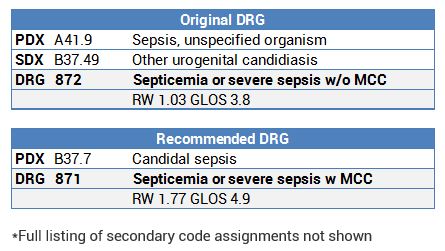Provident has been engaged in ongoing DRG audits since the implementation of ICD-10 in October 2015. We have identified potential DRG audit target areas related to our audit work, changes to the ICD-10 codeset, and Coding Clinic updates. We will be posting target area case summaries with suggested audit strategies regularly in our newsletter. Please see this edition’s case study below:
Case Summary
73-year-old male with a history of diabetes, bladder cancer, status post nephrectomy and history of hydronephrosis, status post nephrostomy that was removed one month ago. He was treated with Levaquin for a UTI but he did not get any better and he presented to the hospital. He was diagnosed with AKI due to hydronephrosis with question of UTI, started on antibiotics and admitted for further evaluation. Both urine and blood cultures were found to be growing candida so he was switched from Zosyn to Fluconazole IV. ID diagnosis was acute cystitis w/sepsis secondary to acute cystitis w/hematuria. Final diagnosis was sepsis secondary to acute pyelonephritis and candida.
DRG Information

Audit Considerations & Strategies
- For the final diagnosis of “sepsis secondary to acute pyelonephritis”, the coder assigned: sepsis, unspecified and urogenital candidiasis (candidal pyelonephritis)
- Since sepsis was linked to candida, a single code for candidal sepsis (B37.7) should be assigned
- Candidal sepsis is designated as a “Principal Diagnosis is its own MCC” for MS-DRGs
- Revising the principal diagnosis shifts the DRG from 872 to 871
- For patients with sepsis, look to see if an antifungal such as Fluconazole (Diflucan) is ordered since it may offer clues as to the source/type of sepsis being treated
- Other types of sepsis that act as their own MCC are:
- Anthrax sepsis (A22.7)
- Erysipelothrix sepsis (A26.7)
- Listerial sepsis (A32.7)
- Gonococcal sepsis (A54.86)
- Severe sepsis with septic shock (R65.21)
Reference
- Clarification: Sepsis due to Non-Candida Albicans: Coding Clinic – 4th Quarter 2014: Page 46
- FY 2017 IPPS Final Rule Homepage
